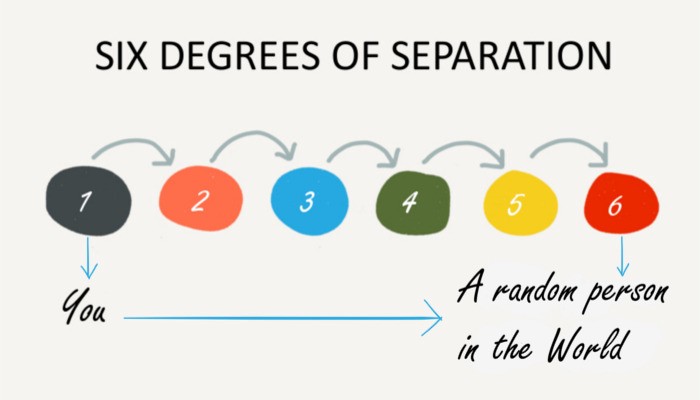It’s a Small, Small World

Ever heard of the theory Six Degrees of Separation? It is the idea that everyone in this planet is connected to every other person through a chain of acquaintances of no more than five. So, through at most five other people, you can be connected to any person on Earth, be it the Queen of England, Donald Trump, Jack Ma, or even someone from the Amazon tribe.
Six Degrees of Separation was first proposed by Frigyes Karinthy, a Hungarian author in 1929 in his short story, Chains (Láncszemek). He believed that the modern world was ‘shrinking’ due to globalization where we become more and more connected, and that despite great physical distances between humans worldwide, the growing density of human networks made the actual social distance far smaller than expected.
Sounds a little far-fetched? Well, take a look at it this way— assuming that everyone knows at least 44 people, and each of those people know another different 44 people, and so on until the sixth step, we can calculate it with 44^6, which is roughly equals to 7.26 billion people. And I’m sure most people know more than 44 people, so the final number turns out to be far greater.
This theory was tested by Stanley Milgram, an American sociologist in 1967. Known as the Small-World Experiment, he randomly selected people in the Midwest to send packages to a stranger in Massachusetts, with only basic information of the recipient such as name, occupation and general location were known. The participants had to send the package to a person they knew on a first-name bases who would most likely know the intended recipient, or know someone who might know the intended recipient. And that person would so the same thing until the package reaches the intended recipient. Although people expected the chain to have over a hundred intermediaries, it was shown that it only took around five to seven intermediaries for each package to be delivered successfully.
And that was in 1967, more than fifty years ago. With the invention of air planes, cars, bullet trains and many others, we have reduced our distance even more. Many other researchers have done their own testing over the years, with increasingly modern tools such as the internet, and came up with similar results.
So, as you can see, everyone can be connected.
And why is this important?
Consider the recent outbreak in Wuhan, China. In January to February 2020, the outbreak was at its peak in China. Despite the alarming infection rate, death tolls and their brutal lockdown methods, the rest of the world did not take this virus seriously. Flights were still going in and out of China. Many countries did not do effective screening. Donald Trump even tweeted that “It’s going to be just fine”. Many thought that the disease was far away, and in their minds, could not touch them. But now, merely 3 months later, the world has been thrown into chaos.
In less than half a year, the virus has spread to the four corners of the world.
Six Degrees of Separation has been proven once again.
Thus, we must understand the consequences of being globally connected. Many of us do not care much beyond our immediate social circle. We care about our family and friends, and our friend’s friends, but anything more than that is just a random person to us.
We can’t think that way anymore. We must be aware of what is exponential growth, and how every action we take has a ripple effect.
As said by Duncan Watts, a mathematician and network theorist,
“People may be oblivious to its full impact in their day-to-day lives, but the network is still there. And if the network is only six degrees, you need to pay attention.”
